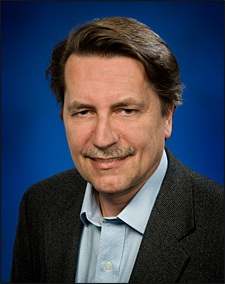Thomas Roser Named Chair of Brookhaven Lab's Collider-Accelerator Department
January 5, 2010
UPTON, NY — Thomas Roser, a senior physicist who joined the U.S. Department of Energy’s Brookhaven National Laboratory in 1991, has been named chair of the Laboratory’s Collider-Accelerator Department (C-AD), effective January 1, 2010. He replaces Derek Lowenstein, who served as C-AD chair for 27 years, and will continue to play key roles in the department.
With about 400 employees and an annual budget of $140 million, C-AD develops, improves and operates a suite of accelerators used for experiments by an international community of about 1,500 scientists. The department also designs and constructs new accelerators in support of the Laboratory’s and national missions.
“I am grateful for Derek Lowenstein’s leadership of C-AD, which has helped to make the department one of the premier institutions for accelerator science and technology in the world,” Roser said. “I hope to build on his success as I look forward to exciting new challenges in the new decade.”
Future challenges include an upgrade of the Relativistic Heavy Ion Collider (RHIC), Brookhaven’s world-class accelerator, where physicists have discovered a type of matter – known as quark-gluon plasma – that is believed to have existed just microseconds after the Big Bang. The upgraded accelerator will provide many more heavy ion collisions and allow physicists to study the quark-gluon plasma in greater detail. A future electron accelerator, added to the RHIC facility and called eRHIC, might make it possible to discover yet another new state of nuclear matter. Currently under construction and due to start operations in 2011 is an Energy Recovery Linac, which will be used for accelerator research and development of the high-intensity electron beams required for eRHIC.
Also part of the C-AD complex is the Booster accelerator, which supplies the ion beams for the NASA Space Radiation Laboratory (NSRL) at Brookhaven, where scientists study the effects of simulated space radiation on biological and physical systems. The goal of this research is the development of methods and materials to reduce the risk of radiation damage to astronauts on prolonged space missions. Roser indicated that the facility might be expanded to allow research on the use of ions for cancer treatment, a therapy that is successfully being employed in Japan and Europe.
The LINAC, a linear accelerator that supplies beams of polarized protons for RHIC, also provides high intensity proton beams for the production of medical isotopes at the Brookhaven Linac Isotope Producer facility. The isotopes are used for medical imaging, cancer treatment, and research at hospitals and medical centers around the world. Roser said this facility might also be expanded or replaced within the next several years.
The Tandem Van de Graaff electrostatic accelerators provide ions for the RHIC accelerator injector chain and for the NSRL facility. In 2011, this function will be taken over by the more efficient Electron Beam Ion Source, a pre-injector system designed by C-AD. The Tandem accelerators also supply ions for radiation testing of electronic components and manufacturing of industrial materials.
Roser earned a Ph.D. in physics from the Swiss Federal Institute of Technology in Zurich in 1984. He became a research fellow at the University of Michigan in the same year and was appointed assistant professor of physics at the university in 1990. He joined Brookhaven Lab as an associate physicist in 1991, and, in 1994, he became the head of the Accelerator Division for Brookhaven’s Alternating Gradient Synchrotron Department, which later became C-AD. In 1999, he was promoted to senior physicist with tenure, and he became the accelerator division head at C-AD, in charge of commissioning RHIC. In addition, he was appointed associate chair for accelerators in 2002.
Roser is a fellow of the American Association for the Advancement of Science, the American Physical Society, and the IEEE. He has been honored with Brookhaven Lab’s Sambamurti Memorial Lectureship Award in 1994, the BNL Science and Technology Award in 2000, and the Nuclear & Plasma Sciences Society/IEEE Particle Accelerator Science and Technology Award in 2005. He has served on numerous advisory committees, and he is currently chair of both the CERN Machine Advisory Committee and the Organizing Committee of the Particle Accelerator Conferences.
2010-11059 | INT/EXT | Newsroom










